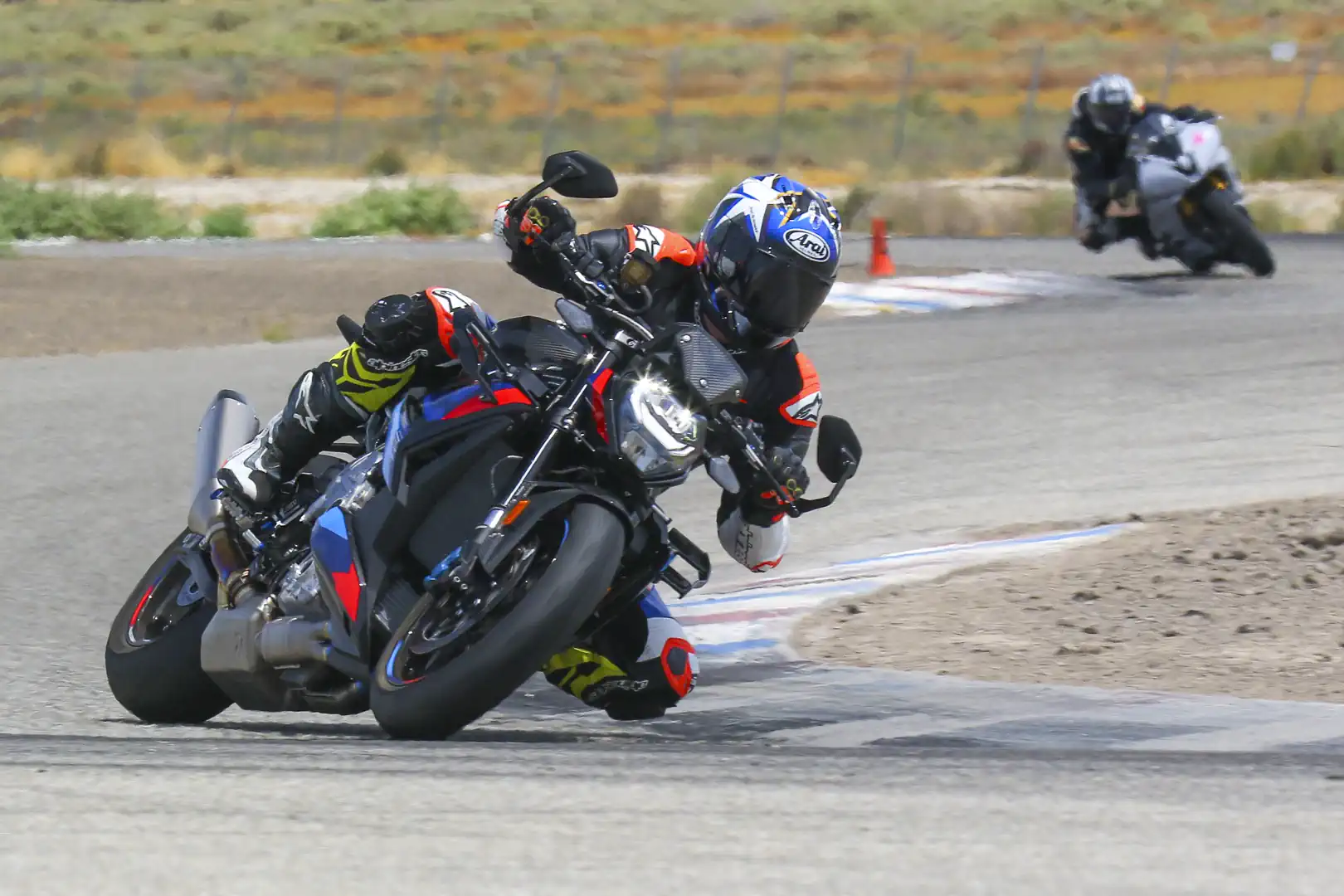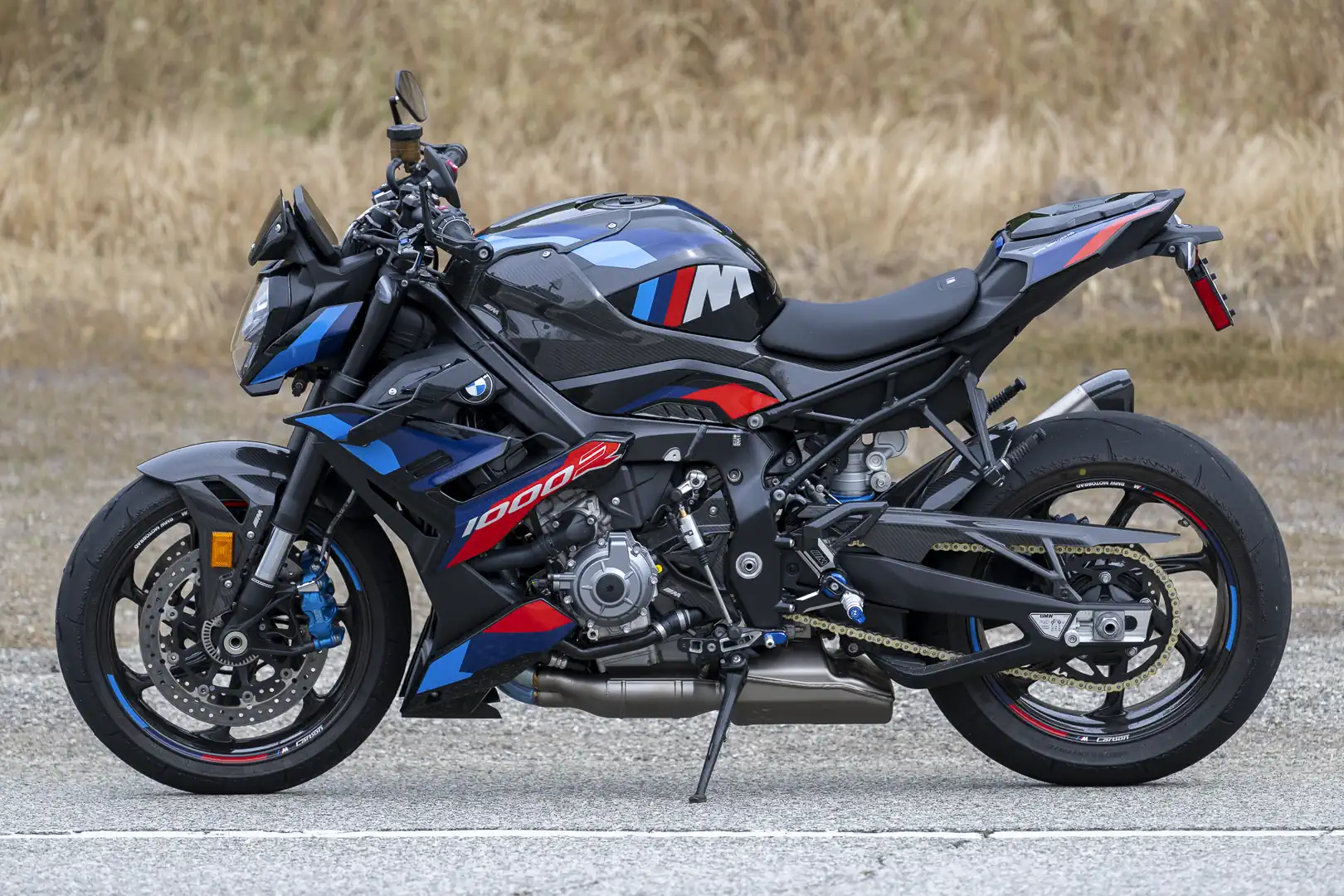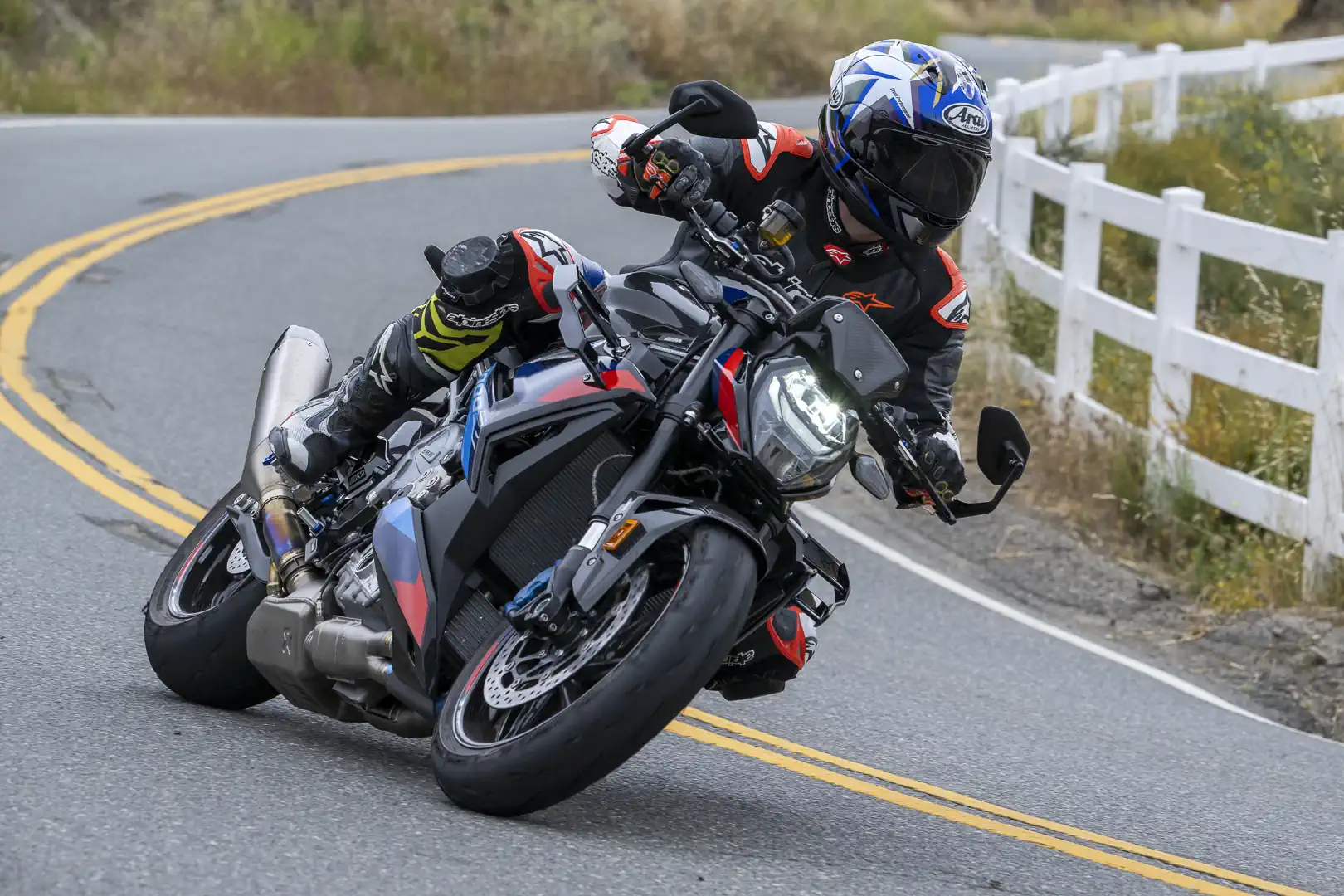There is a simmering arms race in the Super Naked category, and the 2023 BMW M 1000 R is the newest piece of high-tech weaponry to enter the battlefield. Armed with the latest-generation ShiftCam-equipped inline-4 from the S 1000 RR superbike, along with its updated electronic aids, the M 1000 R has ascended to the exclusive 200 horsepower club and now breathes the same rarified air as the Ducati Streetfighter V4 and MV Agusta Brutale 1000 RR moto-missiles. BMW’s S 1000 R, despite its ample 165 ponies, stands as a more-sensible road-oriented choice among today’s power-hungry liter-class naked segment, which often seems aimed at racetrack proving grounds. The M 1000 R wears its M-branding with pride, coupling superbike-derived aerodynamics, electronics, and, of course, the newly minted engine to the sweet-handling S 1000 R chassis. The question remains: Would the M 1000 R’s M-badged power gains obliterate the base bike’s street-savvy nature?
BMW’s S 1000 R, despite its ample 165 ponies, stands as a more-sensible road-oriented choice among today’s power-hungry liter-class naked segment, which often seems aimed at racetrack proving grounds. The M 1000 R wears its M-branding with pride, coupling superbike-derived aerodynamics, electronics, and, of course, the newly minted engine to the sweet-handling S 1000 R chassis. The question remains: Would the M 1000 R’s M-badged power gains obliterate the base bike’s street-savvy nature?
We teamed up with Let’s Ride Trackdays to spin laps around Buttonwillow Raceway Park’s 2.68-mile road course and fired out follow-up street missions to seek those answers. That’s all in a day’s work for any sporting naked bike, so let’s get on with the Fast Facts.
- Our tester boasted the $4995 M Competition Package, which brings plenty of optional go-fast parts into the fold. Besides the exclusive Black Storm Metallic / M Motorsport livery, some pieces genuinely enhance the M-single-R’s performance and should be highlighted before kicking off this review. First, lightweight M carbon fiber wheels shave off 3.7 pounds compared to alloy variants, reducing rotating mass and increasing rear tire width to 200. Next, 0.2-inch thicker 320mm front discs address increased power. Speedy pizzazz is accentuated by all the featherweight carbon fiber bits—fenders, airbox cover, chain and pinion guards, and tank covers. A heaping dose of ergonomic customization is in play with M Billet parts, including anodized aluminum rearsets, shift levers, brake pedal, and levers (all adjustable), plus the passenger pegs. There’s also a passenger seat cover available for a cleaner look. Lastly, the GPS lap timer is unlocked.
- Oh, but that’s not all on the performance front: We also had the $1895 M Titanium exhaust. An Akrapovič titanium muffler is standard on all M-R machines, but this upgrade shaves off nearly six pounds using a titanium header and mid-pipe. Totaling all the goodies, a little over 10 pounds is shaved from the stock M 1000 R’s 439-pound claimed curb weight while they raise the price from $21,345 to a lofty as-tested price of $28,235.
- BMW isn’t messing around anymore when it comes to the naked segment: The 999cc I4 is potent. Transplanting the RR’s superbike engine pumped peak figures to a claimed 205 horsepower at 13,750 rpm and 83 ft-lbs at 11,100 rpm—that’s a whopping 40 horses more than the base bike, and a sniff less peak torque.
- The greatest trick of the M 1000 R is its inviting off-the-line power delivery. Still, titanium valves and a lightweight finger-follower valvetrain mean searing performance is a throttle blip away. Street-friendly grunt is on tap, and stellar roll-on power is usually readily available, but our U.S.-spec bike has a sizable flat spot from 6k-8k that tempers what should be an impressive midrange pull. Once the powerband snaps out of that hole, the exhaust valves open, and the torquey Beemer shrieks towards its 14,500 rpm redline, leaving me with four-letter-word superlatives while blitzing around Buttonwillow. Blistering quick is a tame description, and the top-end intensity masks any high-rpm engine buzz you might feel.
- Noise emission hurdles have yet to be cleared stateside. We first witnessed the aforementioned flat spot in the 2020 BMW S 1000 RR. While improved upon, it persists within BMW’s U.S.-spec sport machines—mainly in 2nd gear, though still felt above that. On the street, it’s an annoyance on slow, technical mountain roads. With larger throttle openings at the racetrack, transitioning out of the rev-slump can be sharp and cause unwanted chassis movement. In either case, keeping the free-revving I4 above 8k is the best solution. BMW Motorrad USA offers Torque Optimized Calibration—exclusive to our market—which Band-Aids the problem by sacrificing top-end power to regain some low and midrange punch. The only fix is with an aftermarket tune, giving you the full-fat version experienced in other markets.
- This transmission defines the word smooth. Engineers tweaked the gearbox for the 2023 BMW M 1000 R’s naked duties by shortening internal ratios in the latter half. It’s a wise choice, as it prioritizes acceleration, which is far more helpful in street environments. For an extra bit of shove, the rear sprocket gained two teeth as well, further shortening overall gearing. Homework done. What’s left is one of the best examples of a sport transmission on the market today, where ultra-short, tight shifting is punctuated by an excellent up/down quickshifter that performs well at any speed.
- Preset and configurable ride modes are standard. Per the usual for BMW, the long list of electronic rider aids is linked directly to four preset riding modes (Rain, Road, Dynamic, and Race) and three customizable Ride Pro modes—and they’re standard, unlike the S 1000 R. At the tap of a button, you’ll adjust semi-active suspension, cornering ABS, adjustable traction control, wheelie control, engine braking adjustment, and Motor Slip Regulation settings that reflect the chosen mode. In addition, other electronic assists include launch control, cruise control, pit lane speed limiter, heated grips, and keyless ignition. Naturally, this is all accessed via the massive full-color 6.5-inch TFT display.
- BMW’s bevy of IMU-supported electronics offers everything a sporting rider could want. Working through the ranks from Road to Race reveals spot-on fueling across the spectrum, as each step unlocks greater engine aggression, tighter suspension settings, and hushed nannies. The Road mode makes the M R feel plush as a pillow for commuting, while Dynamic’s adaptable response makes it a decent choice for general street use. Race and default Race Pro settings are snappiest, designed with race tires and blazing paces in mind, and the three Race Pro settings allowed me to have a variety of setups tailored to my liking. TC, WC, and ABS offer as much or as little as your skill can handle—everything can be disabled for track use—not that most of us would bother. When popped into sportier settings, the aids work seamlessly in the background.
- New tech offers additional refinement. Aside from the usual six-axis IMU and wheel-speed sensors, another data collection point has joined the mix—a steering angle sensor measures how far the handlebars and fork are out of alignment with the chassis. One can see how that information might be helpful for TC or ABS algorithms when managing slides, which I’d wager lends a hand in making these systems so effective. It has paved the way for a new party trick known as Brake Slide Assist, helping riders back the bike under hard braking zones by modulating rear brake inputs and ensuring that riders don’t exceed predetermined drift angles.
- The 2023 BMW M 1000 R is one quick-footed steed. Wielding the current generation twin-spar aluminum Flex Frame, which earns its namesake by utilizing reliefs to reduce rigidity, the M-single-R has a chassis that flatters the senses on the street or track. The tried-and-true S’s neutral characteristics haven’t wilted in the face of newfound power. Instead, an incredible amount of agility has been added. This thing is sharp, carving through corners with precision. Of course, its eagerness to turn in and ability to change direction owes much credit to the lightweight carbon fiber wheels, reducing pesky gyroscopic forces considerably compared to alloy hoops. That’s all to say that a little effort goes a long way, and it’s far less than most of its competitors.
- Semi-active suspension is standard. As a reminder, your suspension settings are tied to the ride mode, with Ride Pro modes opening the door to fiddle with the 45mm Marzocchi fork’s overall damping while the Sachs shock enjoys independent compression and rebound adjustment. In addition, the naked bike simplifies things without ride height adjustment and an adjustable swingarm pivot point, which appear on BMW’s superbikes. Mechanical spring-preload knobs are present for further fiddling.
- At the racetrack, diving into the Ride Pro menu and dialing in your chassis settings is a must to prevent the M R’s extra ponies from rearing up. Once done, chassis composure and good mechanical grip are your reward, and that confidence will build lap after lap. Meanwhile, preset modes Road damping takes the edge off to prioritize comfort in the city, while Dynamic keeps things sensibly taught in the canyons for some spirited riding that doesn’t beat up the rider.
- Fine-tuning the setup could be improved. Despite being quite good, the Italian and German suspension duo don’t reach the gold standard set by semi-active Öhlins equipment in terms of adjustability, and that’s notable because motorcycles aren’t one-size-fits-all beasts. To start, a manual, fixed-damping suspension mode isn’t offered on the M 1000 R, typically seen on comparable machines. While less persnickety riders can overlook that aspect, we also can’t adjust the fork’s compression and rebound rates independently, which nearly all semi-active Öhlins-based systems allow.
- According to the M owner’s manual, you’ll need a “Spring Travel Sensor” to achieve individual damping adjustment on the fork. It’s exclusively available from Alpha Racing, the official BMW Motorrad Motorsport partner, and happens to be the same unit used on the S 1000 RR superbikes. However, Alpha representatives told us it won’t mount on the M R; a compatible mounting bracket is needed, and it hasn’t been developed yet. At this price point, we shouldn’t need an optional component to meet class expectations. Worse, despite being cited in the owner’s manual, it isn’t available at this time.
- Nude, yet even more aerodynamic. Visually, identifying an S or M bike is made easy by spotting the presence of winglets. BMW claims that said aero features add 24.3 pounds of downforce at 137 mph to keep the front end down, reducing wheels and increasing stability, which was the case while barreling down Buttonwillow’s front straight.
- More performance, but the same all-day comfort remains. One of the premier features of the S 1000 R is its perfectly proportioned sport riding position, which is reprised on the M-badged model. The 33.1-inch seat height reads tall on paper, though the mid-section is whittled down to tame the I4-powered bike’s girth. My 32-inch inseam can reach the floor, even with cranked suspension settings. A wide, flat, motocross-style handlebar could make a proper torture rack; thankfully, that description couldn’t be farther from the truth. It works, simply put, making it some of the cozier accommodations in the segment. And with M Competition Package’s adjustable controls, the ergonomics can be tailored for various riders.

- Bridgestone Battlax Racing Street RS11 tires are standard. Bridgestone’s flagship street tires are spooned onto the carbon fiber wheels, which borrow several design elements from the brand’s similarly named Racing R11 tires—heck, even the tread pattern is the same. However, the RS11 rubber seen here is designed to work in a variety of conditions once warmed up, from the street or track, and provide an ample amount of grip. I used them at Buttonwillow and can’t speak highly enough of the front-end confidence from this road-spec rubber. Meanwhile, the rear held up nicely after a handful of sessions.
- M-branded Nissin front calipers bring heavy stopping power. The anodized blue pieces of kit are a cut above the standard naked machine and, with the additional oomph backing the M 1000 R, it’s a welcome boost. A single digit on the lever is all you need in most street situations. You’ll probably go for two at the track when things are hot and heavy. Brembo supplies the rear caliper.
- The 2023 BMW M 1000 R elevates the brand’s naked platform. Joining the 200-horsepower club is no small feat, and BMW should be applauded for retaining the streetwise S 1000 R’s most attractive traits, namely pleasing comfort and stellar handling. In this case, those fronts are pushed forward, as cornering is excellent with the carbon wheels in play, while gaining ground in other categories. Braking power and the M’s electronic gadgetry are impressive. The monstrously powerful engine will peel paint off anything near it when at full chat, though the midrange slump seen stateside is roundly disappointing, especially when most of its competitors aren’t struggling in the same area. BMW didn’t launch a dud, and it’s fitting that the M-single-R boasts winglets, seeing as the highs are, indeed, quite high.
Track photography by CaliPhotograpy
Street photography by Don Williams
RIDING STYLE
- Helmet: Arai Corsair-X
- Suit: Alpinestars GP Tech V4
- Airbag: Alpinestars Tech-Air 5
- Baselayer: VNM Sport compression top and pant
- Gloves: Alpinestars GP Tech V2
- Boots: Alpinestars SuperTech R
2023 BMW M 1000 R Specs
ENGINE
- Type: Inline-4
- Displacement: 999cc
- Bore x stroke: 80 x 49.7mm
- Maximum power: 205 horsepower @ 13,500 rpm
- Maximum torque: 83 ft-lbs @ 11,000 rpm
- Top speed: 174 mph
- Redline: 14,600 rpm
- Compression ratio: 13.3:1
- Valvetrain: DOHC w/ BMW ShiftCam; 4vpc
- Fueling: EFI w/ 48mm throttle body
- Transmission: 6-speed
- Clutch: Wet multiplate w/ slipper function
- Final drive: 525chain
FRAME
- Type: Aluminum composite bridge w/ self-supporting motor
- Front suspension; travel: Adjustable semi-active inverted 45mm Marzocchi fork; 4.7 inches
- Rear suspension; travel: Linkage-assisted fully adjustable semi-active Sachs shock; 4.6 inches
- Wheels: Optional M Carbon (forged aluminum standard)
- Front wheel: 17 x 3.50
- Rear wheel: 17x 6.00
- Front tire: 120/70 x 17
- Rear tire: 200/55 x 17
- Front brakes: 320mm floating discs w/ 4-piston fixed calipers
- Rear brake: 220mm disc w/ Brembo single-piston floating caliper
- ABS: BMW Motorrad Race ABS (defeatable)
DIMENSIONS and CAPACITIES
- Wheelbase: 57.1 inches
- Rake: 24 degrees
- Trail: 3.8 inches
- Seat height: 33.1 inches
- Fuel capacity: 4.4 gallons
- Curb weight: 439 pounds (429 pounds, as tested)
COLORS
- Light White/M Motorsport
- Blackstorm Metallic/M Motorsport (M Competition package)
2023 BMW M 1000 R Price: $21,345 MSRP ($28,235, as tested)
2023 BMW M 1000 R Review Photo Gallery





















































![2024 Suzuki RM-Z250 First Ride Review [Pro Circuit Equipped]](https://ultimatemotorcycling.com/wp-content/uploads/2023/09/2024-suzuki-rm-z250-review-first-ride-6-218x150.webp)
![2023 Aprilia RS 660 Trofeo Review [Laguna Seca Tested] 2023 Aprilia RS 660 Trofeo Review: Track tested](https://ultimatemotorcycling.com/wp-content/uploads/2023/09/2023-aprilia-rs-660-trofeo-review-4-218x150.webp)
